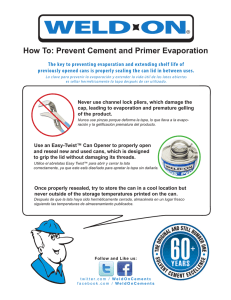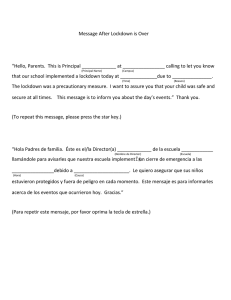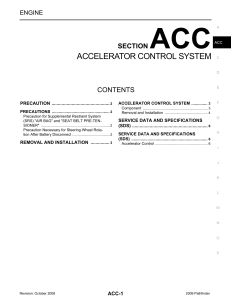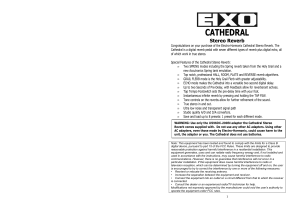Analog Delay - Quickstart Guide - RevA
Anuncio
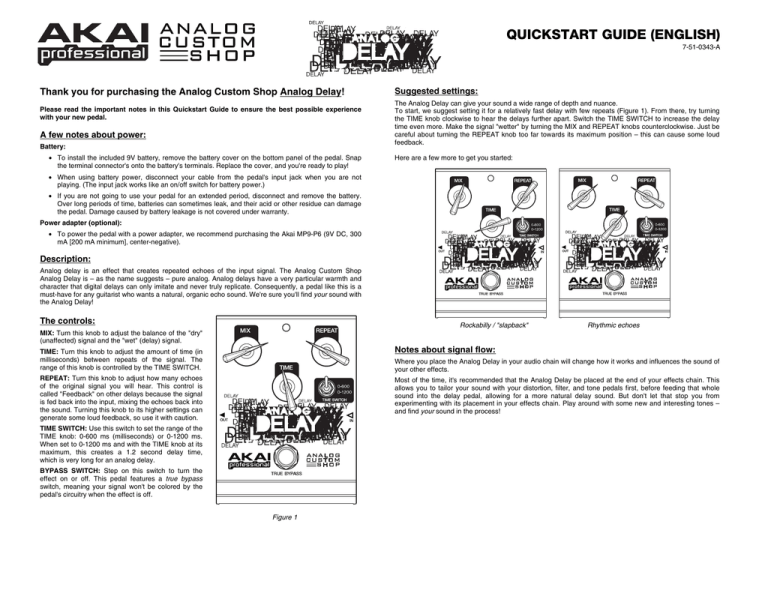
QUICKSTART GUIDE (ENGLISH) 7-51-0343-A Thank you for purchasing the Analog Custom Shop Analog Delay! Please read the important notes in this Quickstart Guide to ensure the best possible experience with your new pedal. A few notes about power: Battery: • To install the included 9V battery, remove the battery cover on the bottom panel of the pedal. Snap the terminal connector's onto the battery's terminals. Replace the cover, and you're ready to play! Suggested settings: The Analog Delay can give your sound a wide range of depth and nuance. To start, we suggest setting it for a relatively fast delay with few repeats (Figure 1). From there, try turning the TIME knob clockwise to hear the delays further apart. Switch the TIME SWITCH to increase the delay time even more. Make the signal "wetter" by turning the MIX and REPEAT knobs counterclockwise. Just be careful about turning the REPEAT knob too far towards its maximum position – this can cause some loud feedback. Here are a few more to get you started: • When using battery power, disconnect your cable from the pedal's input jack when you are not playing. (The input jack works like an on/off switch for battery power.) • If you are not going to use your pedal for an extended period, disconnect and remove the battery. Over long periods of time, batteries can sometimes leak, and their acid or other residue can damage the pedal. Damage caused by battery leakage is not covered under warranty. Power adapter (optional): • To power the pedal with a power adapter, we recommend purchasing the Akai MP9-P6 (9V DC, 300 mA [200 mA minimum], center-negative). Description: Analog delay is an effect that creates repeated echoes of the input signal. The Analog Custom Shop Analog Delay is – as the name suggests – pure analog. Analog delays have a very particular warmth and character that digital delays can only imitate and never truly replicate. Consequently, a pedal like this is a must-have for any guitarist who wants a natural, organic echo sound. We're sure you'll find your sound with the Analog Delay! The controls: Rockabilly / "slapback" Rhythmic echoes MIX: Turn this knob to adjust the balance of the "dry" (unaffected) signal and the "wet" (delay) signal. Notes about signal flow: TIME: Turn this knob to adjust the amount of time (in milliseconds) between repeats of the signal. The range of this knob is controlled by the TIME SWITCH. Where you place the Analog Delay in your audio chain will change how it works and influences the sound of your other effects. REPEAT: Turn this knob to adjust how many echoes of the original signal you will hear. This control is called "Feedback" on other delays because the signal is fed back into the input, mixing the echoes back into the sound. Turning this knob to its higher settings can generate some loud feedback, so use it with caution. Most of the time, it's recommended that the Analog Delay be placed at the end of your effects chain. This allows you to tailor your sound with your distortion, filter, and tone pedals first, before feeding that whole sound into the delay pedal, allowing for a more natural delay sound. But don't let that stop you from experimenting with its placement in your effects chain. Play around with some new and interesting tones – and find your sound in the process! TIME SWITCH: Use this switch to set the range of the TIME knob: 0-600 ms (milliseconds) or 0-1200 ms. When set to 0-1200 ms and with the TIME knob at its maximum, this creates a 1.2 second delay time, which is very long for an analog delay. BYPASS SWITCH: Step on this switch to turn the effect on or off. This pedal features a true bypass switch, meaning your signal won't be colored by the pedal's circuitry when the effect is off. Figure 1 GUÍA DE INICIO RÁPIDO (ESPAÑOL) 7-51-0343-A ¡Gracias por comprar el Analog Delay de Analog Custom Shop! Asegúrese de leer las notas importantes de esta Guía de inicio rápido para asegurar la mejor experiencia posible con su nuevo pedal. Algunas notas acerca de la alimentación: Batería: • Para instalar la batería, retire la cubierta del panel inferior del pedal. Coloque a presión los conectores de los terminales en los terminales de la batería. Vuelva a colocar la cubierta y ¡ya está listo para tocar! Ajustes sugeridos: El Analog Delay puede brindarle a su sonido una amplia gama de profundidad y matices. Para comenzar, sugerimos ajustarla para un retardo relativamente rápido con pocas repeticiones (Figura 1). A partir de allí, pruebe girando la perilla TIEMPO en sentido horario para oír los retardos más separados. Use el CONMUTADOR DE TIEMPO para aumentar el tiempo de retardo aún más. "Humedezca" más la señal girando en sentido horario las perillas de MEZCLA y REPETICIÓN. Simplemente, tenga cuidado de no girar la perilla de REPETICIÓN demasiado lejos hacia su posición de máximo —puede producirse una realimentación muy fuerte. He aquí unos pocos más para que comience: • Cuando use alimentación de batería, desconecte su cable del conector de entrada del pedal cuando no esté tocando. (El conector de entrada funciona como un interruptor de encendido/apagado de la alimentación de batería.) • Si no va a usar su pedal por un período prolongado, desconecte y retire la batería. A lo largo de los períodos prolongados, a veces las baterías tienen fugas y su ácido u otros residuos pueden dañar el pedal. Los daños causados por fugas de la batería no están cubiertos por la garantía. Adaptador de alimentación (opcional): • Para alimentar el pedal con un adaptador de alimentación, recomendamos comprar el Akai MP9-P6 (9 V CC, 300 mA [200 mA mínimo], centro negativo). Descripción: El retardo analógico es un efecto que crea ecos repetidos de la señal de entrada. El retardo analógico de Analog Custom Shop es —como el nombre lo sugiere— analógico puro. Los retardos analógicos poseen una calidez y un carácter particulares que los retardos digitales sólo pueden imitar y nunca reproducir verdaderamente. En consecuencia, un pedal como éste es imprescindible para todo guitarrista que desee un sonido de eco natural y orgánico. ¡Estamos seguros que con el Analog Delay, encontrará su sonido! Los controles: MEZCLA: Gire esta perilla para ajustar el balance de la señal "seca" (sin afectar) y la señal "húmeda" (retardo). Rockabilly / "slapback" Notas acerca del flujo de señal: TIEMPO: Gire esta perilla para ajustar el tiempo (en milisegundos) entre las repeticiones de la señal. El rango de esta perilla lo controla el CONMUTADOR DE TIEMPO. El lugar en que coloque el Analog Delay en su cadena de audio cambia el modo en que funciona e influye en el sonido de sus demás efectos. La mayoría de las veces, se recomienda colocar el Analog Delay al final de su cadena de efectos. Esto le permite personalizar su sonido primero con sus pedales de distorsión, filtro y tono, antes de aplicar el sonido completo al pedal de retardo, permitiendo así un sonido con retardo más natural. Pero no deje que eso le impida experimentar con su ubicación en la cadena de efectos. Juegue un poco con algunos tonos nuevos e interesantes —¡y encuentre su sonido en el proceso! REPETICIÓN: Gire esta perilla para ajustar la cantidad de ecos de la señal original que oirá. Este control se denomina "Feedback" (Realimentación) en otros retardos, porque la señal se realimenta a la entrada, volviendo a mezclar los ecos en el sonido. Si gira esta perilla a sus valores más altos, puede generar realimentación de alto volumen, de modo que debe usarla con precaución. CONMUTADOR DE TIEMPO: Use este conmutador para ajustar el rango de la perilla de TIEMPO: 0-600 ms (milisegundos) o 0-1200 ms. Cuando se ajusta a 0-1200 ms y la perilla TIEMPO está al máximo, se crea un tiempo de retardo de 1.2 segundos, muy largo para un retardo analógico. INTERRUPTOR DE PUENTEO Pise este interruptor para activar y desactivar el efecto. Este pedal cuenta con un interruptor de puenteo verdadero, que significa que la circuitería del pedal no coloreará su señal cuando el efecto está desactivado. Ecos rítmicos Figura 1



